Leadership and Management in Toyota: A Comprehensive Analysis
VerifiedAdded on 2021/01/02
|16
|5582
|116
Report
AI Summary
This report provides a comprehensive analysis of leadership and management practices at Toyota, focusing on the roles and characteristics of leaders and managers within the organization. It delves into the application of leadership and managerial functions across various situational contexts, including team building, project management, and management by objectives. The report further explores different leadership models and theories, such as situational leadership, contingency leadership, and system leadership, and their relevance to Toyota's operational strategies. Key approaches to operations management are discussed, along with the importance and value of operations management in achieving business objectives. Finally, the report examines the factors within Toyota's business environment that impact operational management and decision-making processes, offering a well-rounded understanding of leadership and management in a global automotive context.
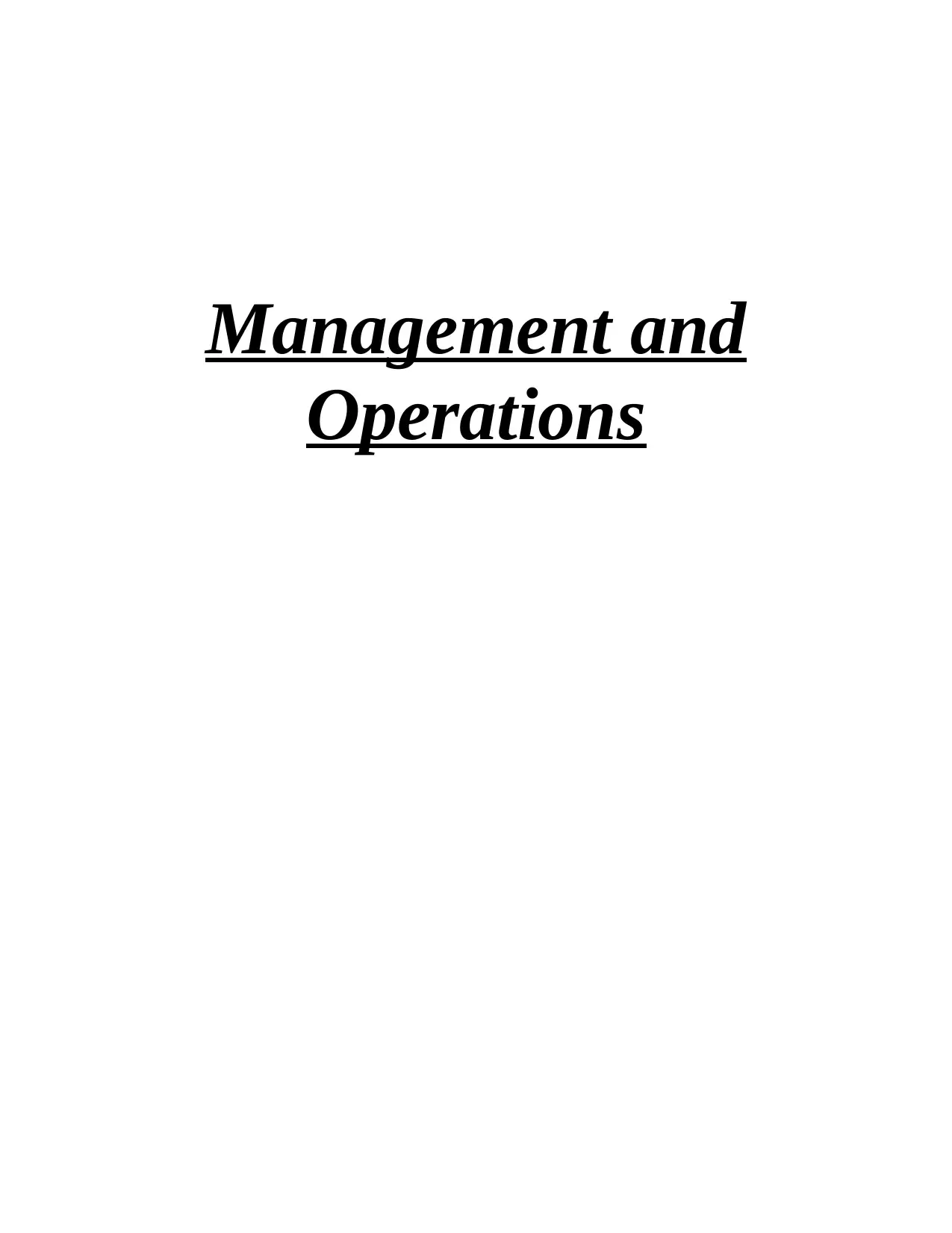
Management and
Operations
Operations
Paraphrase This Document
Need a fresh take? Get an instant paraphrase of this document with our AI Paraphraser
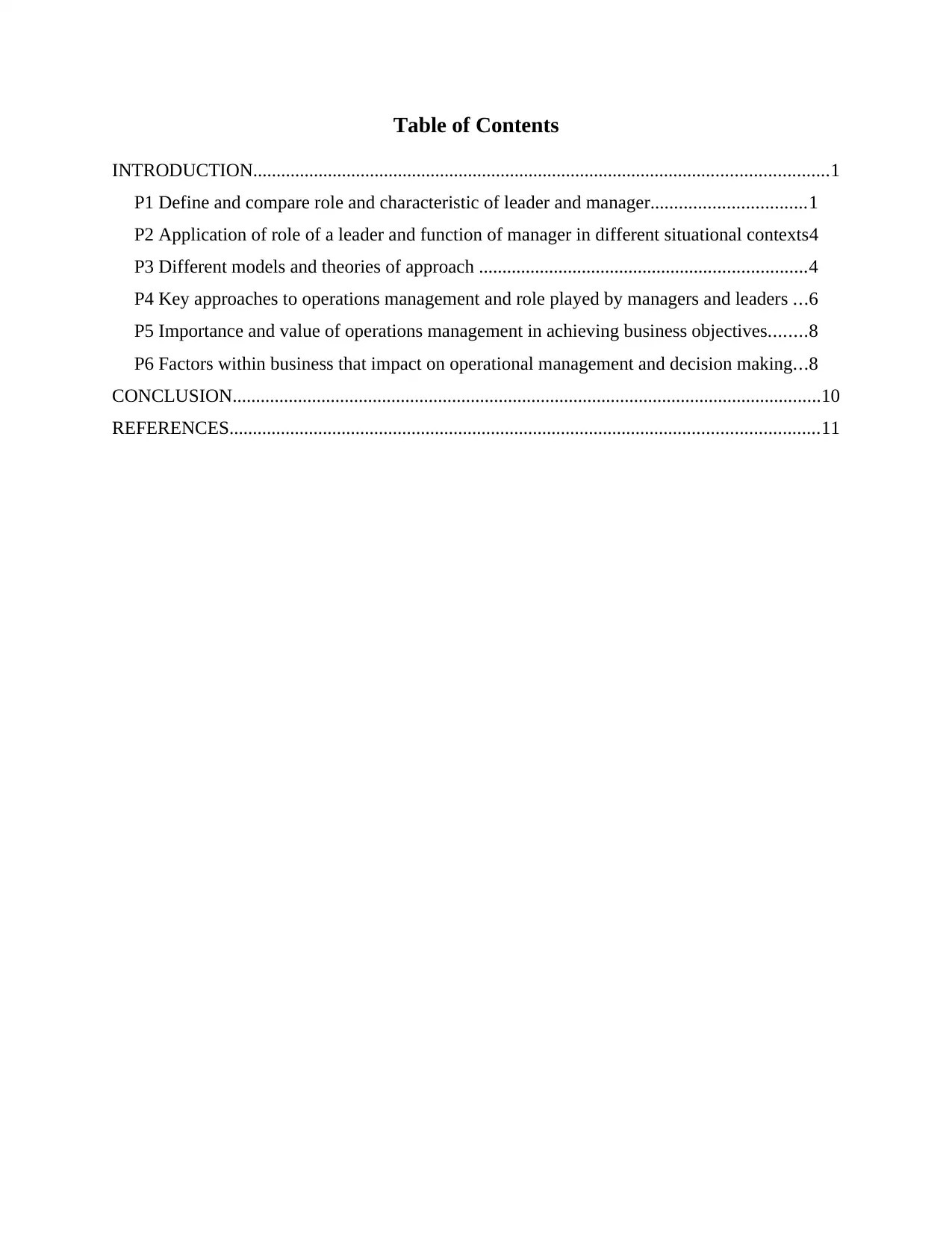
Table of Contents
INTRODUCTION...........................................................................................................................1
P1 Define and compare role and characteristic of leader and manager.................................1
P2 Application of role of a leader and function of manager in different situational contexts4
P3 Different models and theories of approach ......................................................................4
P4 Key approaches to operations management and role played by managers and leaders ...6
P5 Importance and value of operations management in achieving business objectives........8
P6 Factors within business that impact on operational management and decision making...8
CONCLUSION..............................................................................................................................10
REFERENCES..............................................................................................................................11
INTRODUCTION...........................................................................................................................1
P1 Define and compare role and characteristic of leader and manager.................................1
P2 Application of role of a leader and function of manager in different situational contexts4
P3 Different models and theories of approach ......................................................................4
P4 Key approaches to operations management and role played by managers and leaders ...6
P5 Importance and value of operations management in achieving business objectives........8
P6 Factors within business that impact on operational management and decision making...8
CONCLUSION..............................................................................................................................10
REFERENCES..............................................................................................................................11
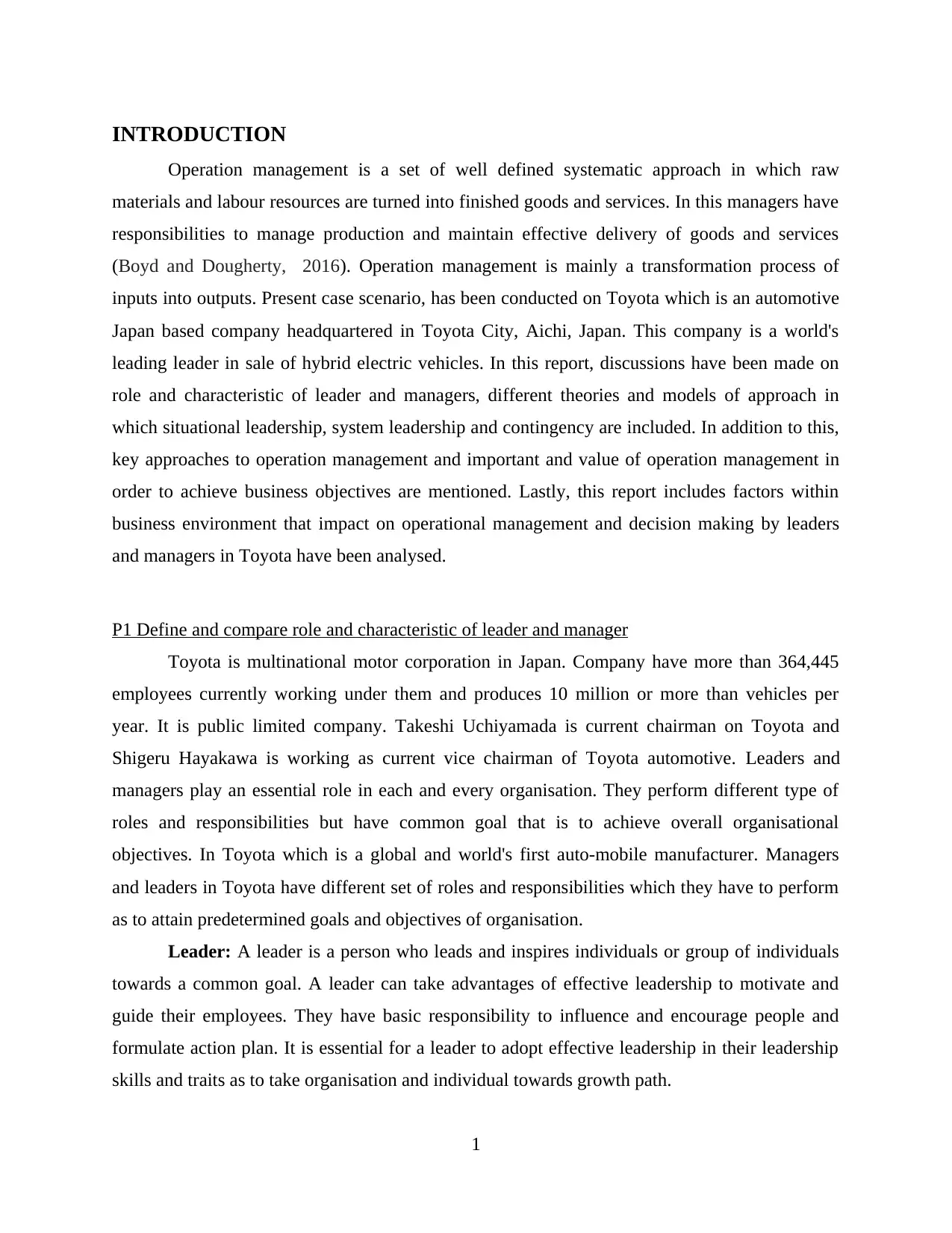
INTRODUCTION
Operation management is a set of well defined systematic approach in which raw
materials and labour resources are turned into finished goods and services. In this managers have
responsibilities to manage production and maintain effective delivery of goods and services
(Boyd and Dougherty, 2016). Operation management is mainly a transformation process of
inputs into outputs. Present case scenario, has been conducted on Toyota which is an automotive
Japan based company headquartered in Toyota City, Aichi, Japan. This company is a world's
leading leader in sale of hybrid electric vehicles. In this report, discussions have been made on
role and characteristic of leader and managers, different theories and models of approach in
which situational leadership, system leadership and contingency are included. In addition to this,
key approaches to operation management and important and value of operation management in
order to achieve business objectives are mentioned. Lastly, this report includes factors within
business environment that impact on operational management and decision making by leaders
and managers in Toyota have been analysed.
P1 Define and compare role and characteristic of leader and manager
Toyota is multinational motor corporation in Japan. Company have more than 364,445
employees currently working under them and produces 10 million or more than vehicles per
year. It is public limited company. Takeshi Uchiyamada is current chairman on Toyota and
Shigeru Hayakawa is working as current vice chairman of Toyota automotive. Leaders and
managers play an essential role in each and every organisation. They perform different type of
roles and responsibilities but have common goal that is to achieve overall organisational
objectives. In Toyota which is a global and world's first auto-mobile manufacturer. Managers
and leaders in Toyota have different set of roles and responsibilities which they have to perform
as to attain predetermined goals and objectives of organisation.
Leader: A leader is a person who leads and inspires individuals or group of individuals
towards a common goal. A leader can take advantages of effective leadership to motivate and
guide their employees. They have basic responsibility to influence and encourage people and
formulate action plan. It is essential for a leader to adopt effective leadership in their leadership
skills and traits as to take organisation and individual towards growth path.
1
Operation management is a set of well defined systematic approach in which raw
materials and labour resources are turned into finished goods and services. In this managers have
responsibilities to manage production and maintain effective delivery of goods and services
(Boyd and Dougherty, 2016). Operation management is mainly a transformation process of
inputs into outputs. Present case scenario, has been conducted on Toyota which is an automotive
Japan based company headquartered in Toyota City, Aichi, Japan. This company is a world's
leading leader in sale of hybrid electric vehicles. In this report, discussions have been made on
role and characteristic of leader and managers, different theories and models of approach in
which situational leadership, system leadership and contingency are included. In addition to this,
key approaches to operation management and important and value of operation management in
order to achieve business objectives are mentioned. Lastly, this report includes factors within
business environment that impact on operational management and decision making by leaders
and managers in Toyota have been analysed.
P1 Define and compare role and characteristic of leader and manager
Toyota is multinational motor corporation in Japan. Company have more than 364,445
employees currently working under them and produces 10 million or more than vehicles per
year. It is public limited company. Takeshi Uchiyamada is current chairman on Toyota and
Shigeru Hayakawa is working as current vice chairman of Toyota automotive. Leaders and
managers play an essential role in each and every organisation. They perform different type of
roles and responsibilities but have common goal that is to achieve overall organisational
objectives. In Toyota which is a global and world's first auto-mobile manufacturer. Managers
and leaders in Toyota have different set of roles and responsibilities which they have to perform
as to attain predetermined goals and objectives of organisation.
Leader: A leader is a person who leads and inspires individuals or group of individuals
towards a common goal. A leader can take advantages of effective leadership to motivate and
guide their employees. They have basic responsibility to influence and encourage people and
formulate action plan. It is essential for a leader to adopt effective leadership in their leadership
skills and traits as to take organisation and individual towards growth path.
1
⊘ This is a preview!⊘
Do you want full access?
Subscribe today to unlock all pages.

Trusted by 1+ million students worldwide
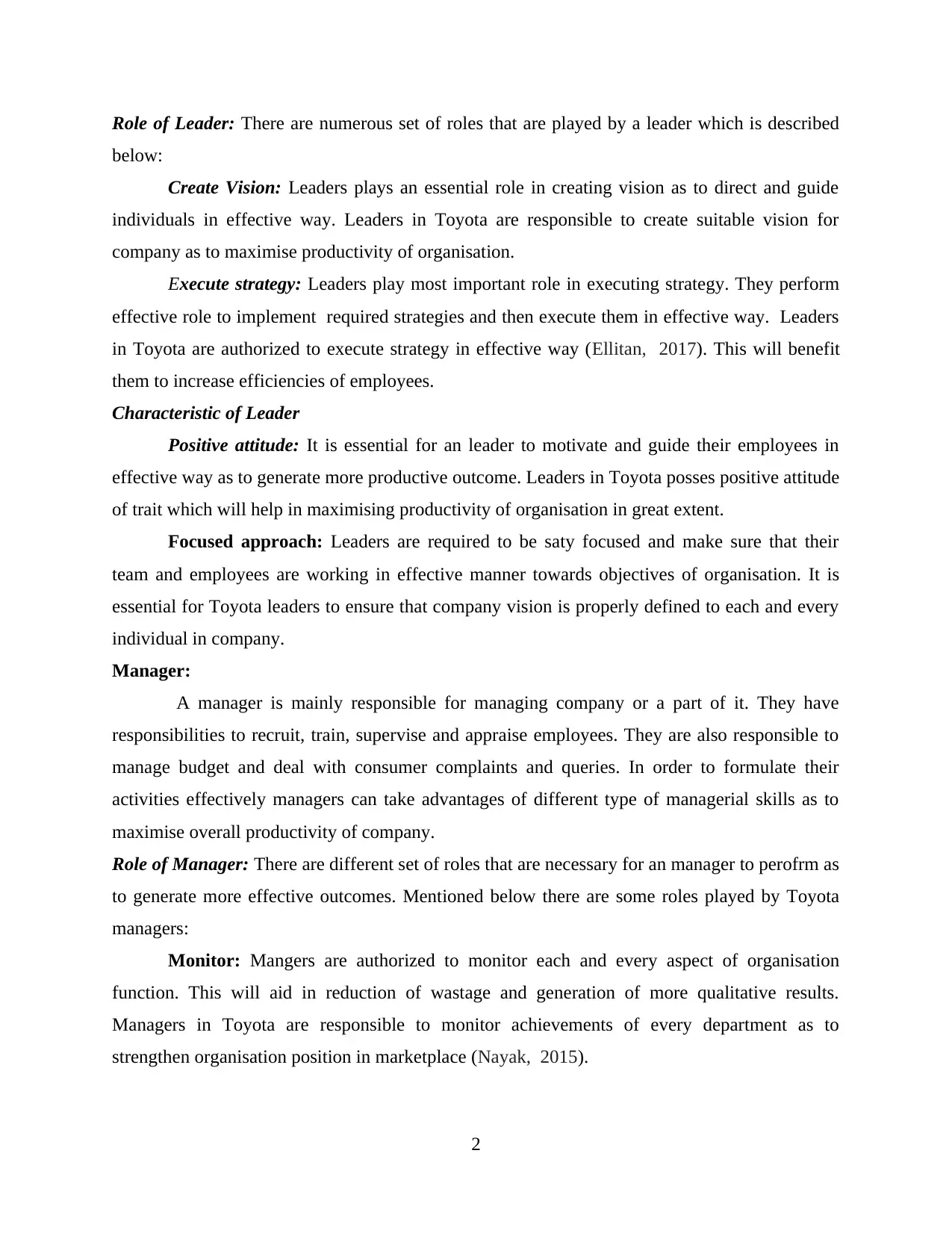
Role of Leader: There are numerous set of roles that are played by a leader which is described
below:
Create Vision: Leaders plays an essential role in creating vision as to direct and guide
individuals in effective way. Leaders in Toyota are responsible to create suitable vision for
company as to maximise productivity of organisation.
Execute strategy: Leaders play most important role in executing strategy. They perform
effective role to implement required strategies and then execute them in effective way. Leaders
in Toyota are authorized to execute strategy in effective way (Ellitan, 2017). This will benefit
them to increase efficiencies of employees.
Characteristic of Leader
Positive attitude: It is essential for an leader to motivate and guide their employees in
effective way as to generate more productive outcome. Leaders in Toyota posses positive attitude
of trait which will help in maximising productivity of organisation in great extent.
Focused approach: Leaders are required to be saty focused and make sure that their
team and employees are working in effective manner towards objectives of organisation. It is
essential for Toyota leaders to ensure that company vision is properly defined to each and every
individual in company.
Manager:
A manager is mainly responsible for managing company or a part of it. They have
responsibilities to recruit, train, supervise and appraise employees. They are also responsible to
manage budget and deal with consumer complaints and queries. In order to formulate their
activities effectively managers can take advantages of different type of managerial skills as to
maximise overall productivity of company.
Role of Manager: There are different set of roles that are necessary for an manager to perofrm as
to generate more effective outcomes. Mentioned below there are some roles played by Toyota
managers:
Monitor: Mangers are authorized to monitor each and every aspect of organisation
function. This will aid in reduction of wastage and generation of more qualitative results.
Managers in Toyota are responsible to monitor achievements of every department as to
strengthen organisation position in marketplace (Nayak, 2015).
2
below:
Create Vision: Leaders plays an essential role in creating vision as to direct and guide
individuals in effective way. Leaders in Toyota are responsible to create suitable vision for
company as to maximise productivity of organisation.
Execute strategy: Leaders play most important role in executing strategy. They perform
effective role to implement required strategies and then execute them in effective way. Leaders
in Toyota are authorized to execute strategy in effective way (Ellitan, 2017). This will benefit
them to increase efficiencies of employees.
Characteristic of Leader
Positive attitude: It is essential for an leader to motivate and guide their employees in
effective way as to generate more productive outcome. Leaders in Toyota posses positive attitude
of trait which will help in maximising productivity of organisation in great extent.
Focused approach: Leaders are required to be saty focused and make sure that their
team and employees are working in effective manner towards objectives of organisation. It is
essential for Toyota leaders to ensure that company vision is properly defined to each and every
individual in company.
Manager:
A manager is mainly responsible for managing company or a part of it. They have
responsibilities to recruit, train, supervise and appraise employees. They are also responsible to
manage budget and deal with consumer complaints and queries. In order to formulate their
activities effectively managers can take advantages of different type of managerial skills as to
maximise overall productivity of company.
Role of Manager: There are different set of roles that are necessary for an manager to perofrm as
to generate more effective outcomes. Mentioned below there are some roles played by Toyota
managers:
Monitor: Mangers are authorized to monitor each and every aspect of organisation
function. This will aid in reduction of wastage and generation of more qualitative results.
Managers in Toyota are responsible to monitor achievements of every department as to
strengthen organisation position in marketplace (Nayak, 2015).
2
Paraphrase This Document
Need a fresh take? Get an instant paraphrase of this document with our AI Paraphraser
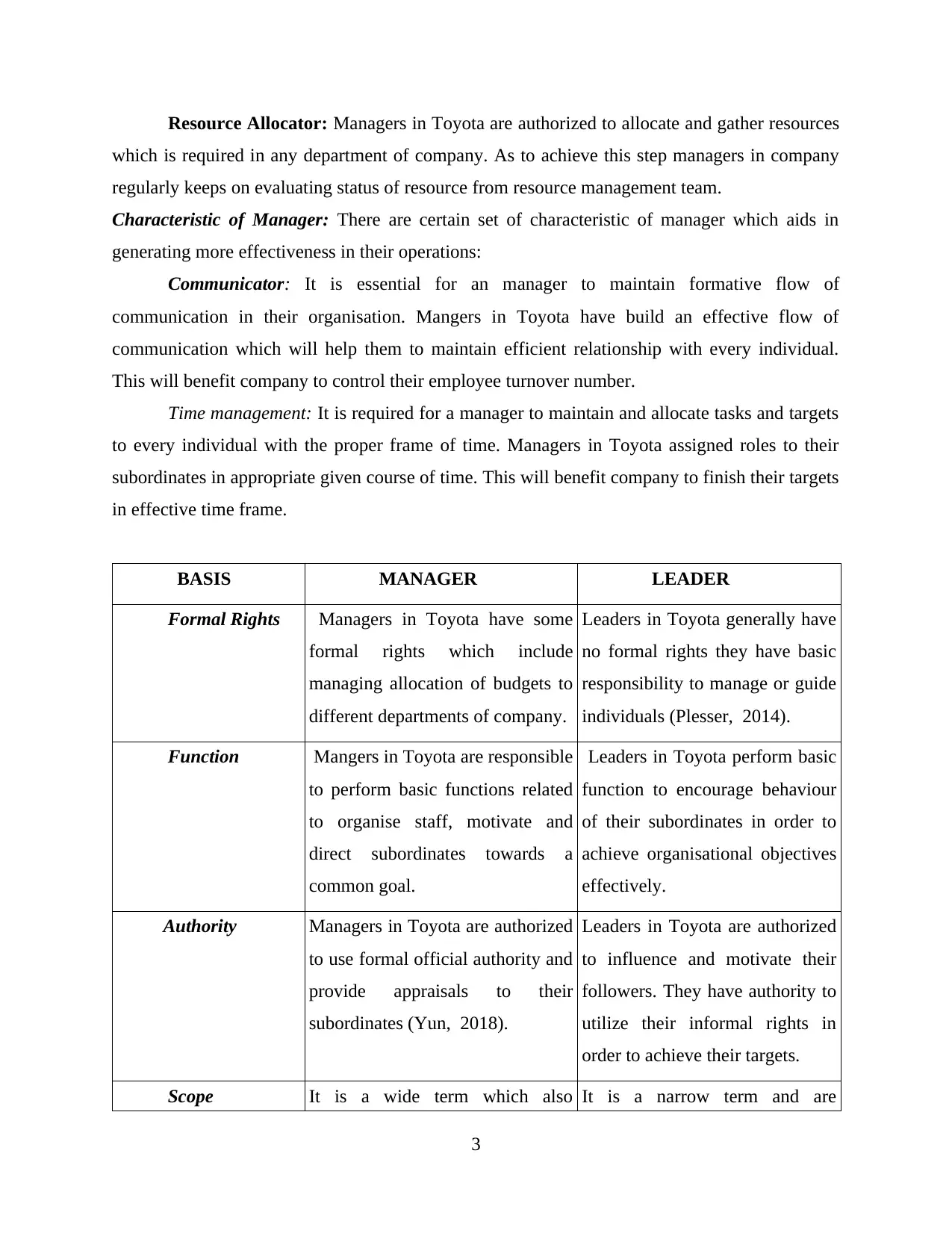
Resource Allocator: Managers in Toyota are authorized to allocate and gather resources
which is required in any department of company. As to achieve this step managers in company
regularly keeps on evaluating status of resource from resource management team.
Characteristic of Manager: There are certain set of characteristic of manager which aids in
generating more effectiveness in their operations:
Communicator: It is essential for an manager to maintain formative flow of
communication in their organisation. Mangers in Toyota have build an effective flow of
communication which will help them to maintain efficient relationship with every individual.
This will benefit company to control their employee turnover number.
Time management: It is required for a manager to maintain and allocate tasks and targets
to every individual with the proper frame of time. Managers in Toyota assigned roles to their
subordinates in appropriate given course of time. This will benefit company to finish their targets
in effective time frame.
BASIS MANAGER LEADER
Formal Rights Managers in Toyota have some
formal rights which include
managing allocation of budgets to
different departments of company.
Leaders in Toyota generally have
no formal rights they have basic
responsibility to manage or guide
individuals (Plesser, 2014).
Function Mangers in Toyota are responsible
to perform basic functions related
to organise staff, motivate and
direct subordinates towards a
common goal.
Leaders in Toyota perform basic
function to encourage behaviour
of their subordinates in order to
achieve organisational objectives
effectively.
Authority Managers in Toyota are authorized
to use formal official authority and
provide appraisals to their
subordinates (Yun, 2018).
Leaders in Toyota are authorized
to influence and motivate their
followers. They have authority to
utilize their informal rights in
order to achieve their targets.
Scope It is a wide term which also It is a narrow term and are
3
which is required in any department of company. As to achieve this step managers in company
regularly keeps on evaluating status of resource from resource management team.
Characteristic of Manager: There are certain set of characteristic of manager which aids in
generating more effectiveness in their operations:
Communicator: It is essential for an manager to maintain formative flow of
communication in their organisation. Mangers in Toyota have build an effective flow of
communication which will help them to maintain efficient relationship with every individual.
This will benefit company to control their employee turnover number.
Time management: It is required for a manager to maintain and allocate tasks and targets
to every individual with the proper frame of time. Managers in Toyota assigned roles to their
subordinates in appropriate given course of time. This will benefit company to finish their targets
in effective time frame.
BASIS MANAGER LEADER
Formal Rights Managers in Toyota have some
formal rights which include
managing allocation of budgets to
different departments of company.
Leaders in Toyota generally have
no formal rights they have basic
responsibility to manage or guide
individuals (Plesser, 2014).
Function Mangers in Toyota are responsible
to perform basic functions related
to organise staff, motivate and
direct subordinates towards a
common goal.
Leaders in Toyota perform basic
function to encourage behaviour
of their subordinates in order to
achieve organisational objectives
effectively.
Authority Managers in Toyota are authorized
to use formal official authority and
provide appraisals to their
subordinates (Yun, 2018).
Leaders in Toyota are authorized
to influence and motivate their
followers. They have authority to
utilize their informal rights in
order to achieve their targets.
Scope It is a wide term which also It is a narrow term and are
3
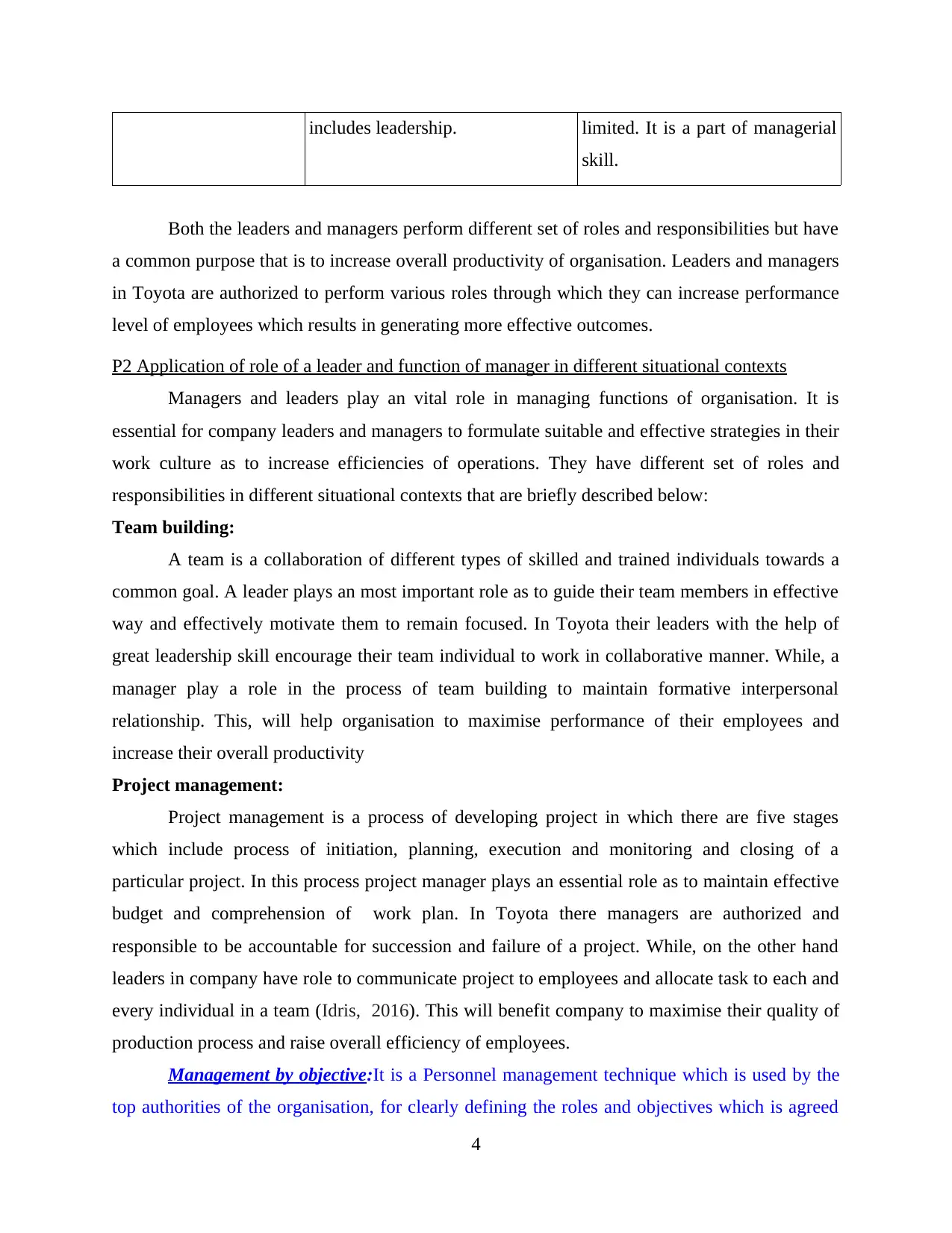
includes leadership. limited. It is a part of managerial
skill.
Both the leaders and managers perform different set of roles and responsibilities but have
a common purpose that is to increase overall productivity of organisation. Leaders and managers
in Toyota are authorized to perform various roles through which they can increase performance
level of employees which results in generating more effective outcomes.
P2 Application of role of a leader and function of manager in different situational contexts
Managers and leaders play an vital role in managing functions of organisation. It is
essential for company leaders and managers to formulate suitable and effective strategies in their
work culture as to increase efficiencies of operations. They have different set of roles and
responsibilities in different situational contexts that are briefly described below:
Team building:
A team is a collaboration of different types of skilled and trained individuals towards a
common goal. A leader plays an most important role as to guide their team members in effective
way and effectively motivate them to remain focused. In Toyota their leaders with the help of
great leadership skill encourage their team individual to work in collaborative manner. While, a
manager play a role in the process of team building to maintain formative interpersonal
relationship. This, will help organisation to maximise performance of their employees and
increase their overall productivity
Project management:
Project management is a process of developing project in which there are five stages
which include process of initiation, planning, execution and monitoring and closing of a
particular project. In this process project manager plays an essential role as to maintain effective
budget and comprehension of work plan. In Toyota there managers are authorized and
responsible to be accountable for succession and failure of a project. While, on the other hand
leaders in company have role to communicate project to employees and allocate task to each and
every individual in a team (Idris, 2016). This will benefit company to maximise their quality of
production process and raise overall efficiency of employees.
Management by objective:It is a Personnel management technique which is used by the
top authorities of the organisation, for clearly defining the roles and objectives which is agreed
4
skill.
Both the leaders and managers perform different set of roles and responsibilities but have
a common purpose that is to increase overall productivity of organisation. Leaders and managers
in Toyota are authorized to perform various roles through which they can increase performance
level of employees which results in generating more effective outcomes.
P2 Application of role of a leader and function of manager in different situational contexts
Managers and leaders play an vital role in managing functions of organisation. It is
essential for company leaders and managers to formulate suitable and effective strategies in their
work culture as to increase efficiencies of operations. They have different set of roles and
responsibilities in different situational contexts that are briefly described below:
Team building:
A team is a collaboration of different types of skilled and trained individuals towards a
common goal. A leader plays an most important role as to guide their team members in effective
way and effectively motivate them to remain focused. In Toyota their leaders with the help of
great leadership skill encourage their team individual to work in collaborative manner. While, a
manager play a role in the process of team building to maintain formative interpersonal
relationship. This, will help organisation to maximise performance of their employees and
increase their overall productivity
Project management:
Project management is a process of developing project in which there are five stages
which include process of initiation, planning, execution and monitoring and closing of a
particular project. In this process project manager plays an essential role as to maintain effective
budget and comprehension of work plan. In Toyota there managers are authorized and
responsible to be accountable for succession and failure of a project. While, on the other hand
leaders in company have role to communicate project to employees and allocate task to each and
every individual in a team (Idris, 2016). This will benefit company to maximise their quality of
production process and raise overall efficiency of employees.
Management by objective:It is a Personnel management technique which is used by the
top authorities of the organisation, for clearly defining the roles and objectives which is agreed
4
⊘ This is a preview!⊘
Do you want full access?
Subscribe today to unlock all pages.

Trusted by 1+ million students worldwide
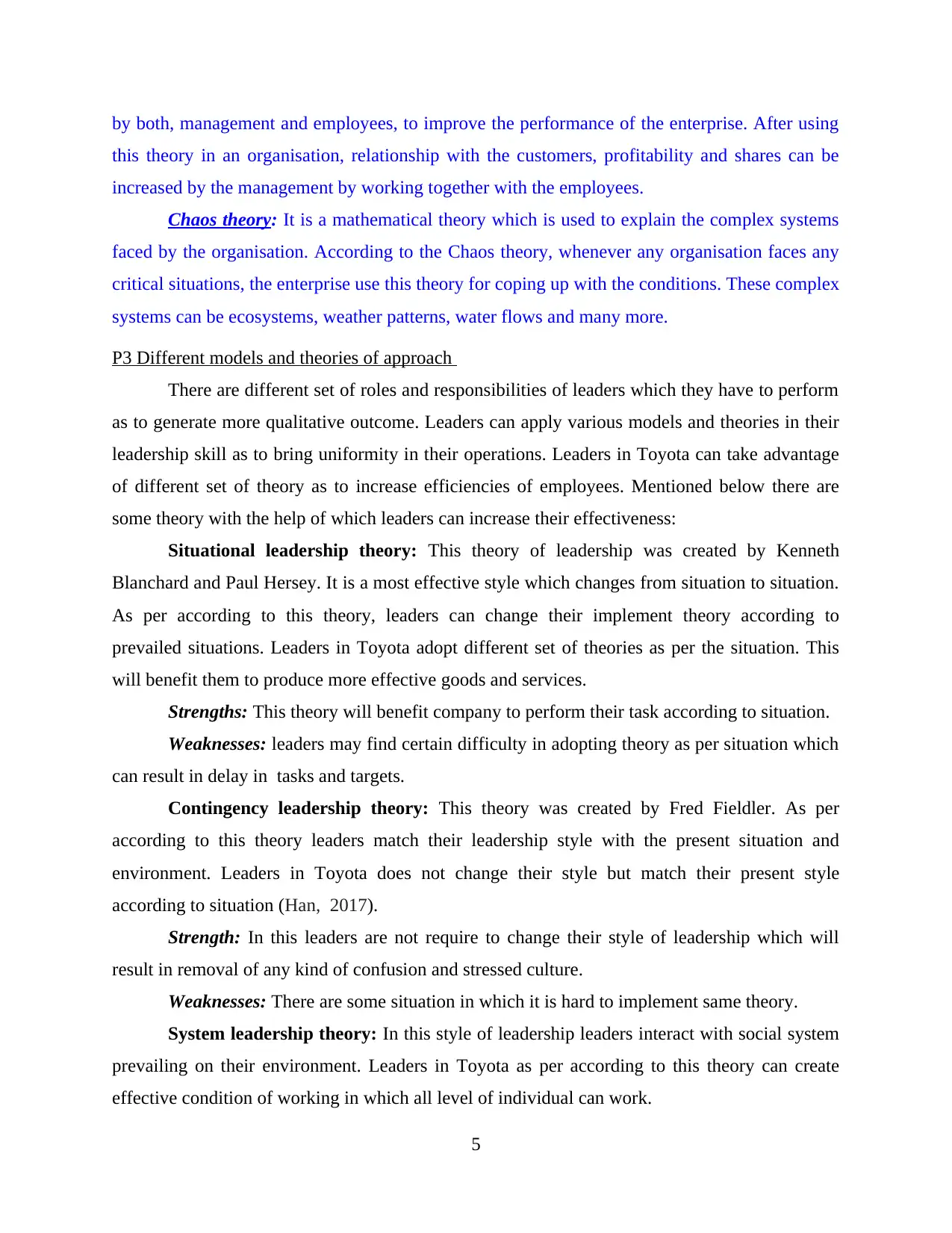
by both, management and employees, to improve the performance of the enterprise. After using
this theory in an organisation, relationship with the customers, profitability and shares can be
increased by the management by working together with the employees.
Chaos theory: It is a mathematical theory which is used to explain the complex systems
faced by the organisation. According to the Chaos theory, whenever any organisation faces any
critical situations, the enterprise use this theory for coping up with the conditions. These complex
systems can be ecosystems, weather patterns, water flows and many more.
P3 Different models and theories of approach
There are different set of roles and responsibilities of leaders which they have to perform
as to generate more qualitative outcome. Leaders can apply various models and theories in their
leadership skill as to bring uniformity in their operations. Leaders in Toyota can take advantage
of different set of theory as to increase efficiencies of employees. Mentioned below there are
some theory with the help of which leaders can increase their effectiveness:
Situational leadership theory: This theory of leadership was created by Kenneth
Blanchard and Paul Hersey. It is a most effective style which changes from situation to situation.
As per according to this theory, leaders can change their implement theory according to
prevailed situations. Leaders in Toyota adopt different set of theories as per the situation. This
will benefit them to produce more effective goods and services.
Strengths: This theory will benefit company to perform their task according to situation.
Weaknesses: leaders may find certain difficulty in adopting theory as per situation which
can result in delay in tasks and targets.
Contingency leadership theory: This theory was created by Fred Fieldler. As per
according to this theory leaders match their leadership style with the present situation and
environment. Leaders in Toyota does not change their style but match their present style
according to situation (Han, 2017).
Strength: In this leaders are not require to change their style of leadership which will
result in removal of any kind of confusion and stressed culture.
Weaknesses: There are some situation in which it is hard to implement same theory.
System leadership theory: In this style of leadership leaders interact with social system
prevailing on their environment. Leaders in Toyota as per according to this theory can create
effective condition of working in which all level of individual can work.
5
this theory in an organisation, relationship with the customers, profitability and shares can be
increased by the management by working together with the employees.
Chaos theory: It is a mathematical theory which is used to explain the complex systems
faced by the organisation. According to the Chaos theory, whenever any organisation faces any
critical situations, the enterprise use this theory for coping up with the conditions. These complex
systems can be ecosystems, weather patterns, water flows and many more.
P3 Different models and theories of approach
There are different set of roles and responsibilities of leaders which they have to perform
as to generate more qualitative outcome. Leaders can apply various models and theories in their
leadership skill as to bring uniformity in their operations. Leaders in Toyota can take advantage
of different set of theory as to increase efficiencies of employees. Mentioned below there are
some theory with the help of which leaders can increase their effectiveness:
Situational leadership theory: This theory of leadership was created by Kenneth
Blanchard and Paul Hersey. It is a most effective style which changes from situation to situation.
As per according to this theory, leaders can change their implement theory according to
prevailed situations. Leaders in Toyota adopt different set of theories as per the situation. This
will benefit them to produce more effective goods and services.
Strengths: This theory will benefit company to perform their task according to situation.
Weaknesses: leaders may find certain difficulty in adopting theory as per situation which
can result in delay in tasks and targets.
Contingency leadership theory: This theory was created by Fred Fieldler. As per
according to this theory leaders match their leadership style with the present situation and
environment. Leaders in Toyota does not change their style but match their present style
according to situation (Han, 2017).
Strength: In this leaders are not require to change their style of leadership which will
result in removal of any kind of confusion and stressed culture.
Weaknesses: There are some situation in which it is hard to implement same theory.
System leadership theory: In this style of leadership leaders interact with social system
prevailing on their environment. Leaders in Toyota as per according to this theory can create
effective condition of working in which all level of individual can work.
5
Paraphrase This Document
Need a fresh take? Get an instant paraphrase of this document with our AI Paraphraser
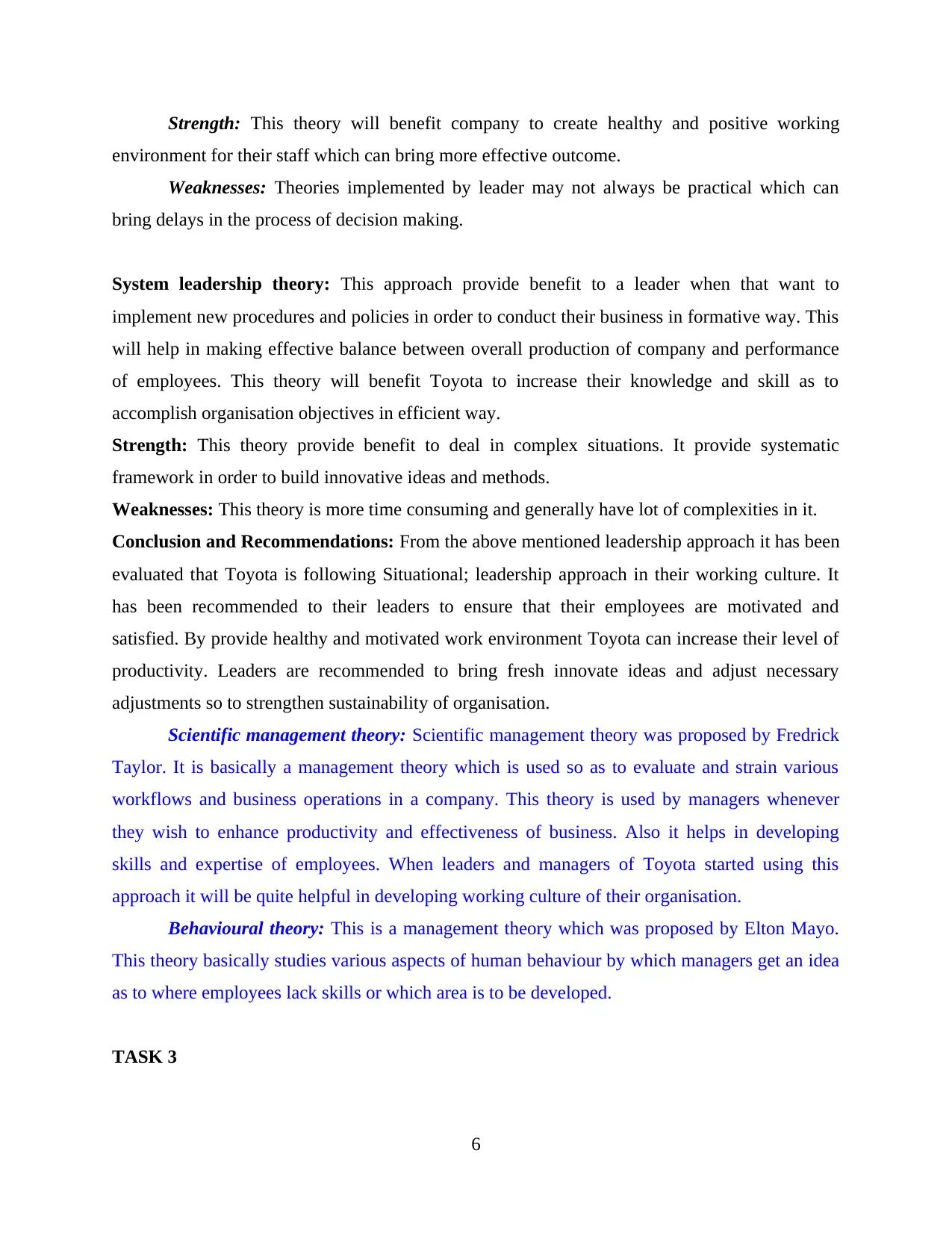
Strength: This theory will benefit company to create healthy and positive working
environment for their staff which can bring more effective outcome.
Weaknesses: Theories implemented by leader may not always be practical which can
bring delays in the process of decision making.
System leadership theory: This approach provide benefit to a leader when that want to
implement new procedures and policies in order to conduct their business in formative way. This
will help in making effective balance between overall production of company and performance
of employees. This theory will benefit Toyota to increase their knowledge and skill as to
accomplish organisation objectives in efficient way.
Strength: This theory provide benefit to deal in complex situations. It provide systematic
framework in order to build innovative ideas and methods.
Weaknesses: This theory is more time consuming and generally have lot of complexities in it.
Conclusion and Recommendations: From the above mentioned leadership approach it has been
evaluated that Toyota is following Situational; leadership approach in their working culture. It
has been recommended to their leaders to ensure that their employees are motivated and
satisfied. By provide healthy and motivated work environment Toyota can increase their level of
productivity. Leaders are recommended to bring fresh innovate ideas and adjust necessary
adjustments so to strengthen sustainability of organisation.
Scientific management theory: Scientific management theory was proposed by Fredrick
Taylor. It is basically a management theory which is used so as to evaluate and strain various
workflows and business operations in a company. This theory is used by managers whenever
they wish to enhance productivity and effectiveness of business. Also it helps in developing
skills and expertise of employees. When leaders and managers of Toyota started using this
approach it will be quite helpful in developing working culture of their organisation.
Behavioural theory: This is a management theory which was proposed by Elton Mayo.
This theory basically studies various aspects of human behaviour by which managers get an idea
as to where employees lack skills or which area is to be developed.
TASK 3
6
environment for their staff which can bring more effective outcome.
Weaknesses: Theories implemented by leader may not always be practical which can
bring delays in the process of decision making.
System leadership theory: This approach provide benefit to a leader when that want to
implement new procedures and policies in order to conduct their business in formative way. This
will help in making effective balance between overall production of company and performance
of employees. This theory will benefit Toyota to increase their knowledge and skill as to
accomplish organisation objectives in efficient way.
Strength: This theory provide benefit to deal in complex situations. It provide systematic
framework in order to build innovative ideas and methods.
Weaknesses: This theory is more time consuming and generally have lot of complexities in it.
Conclusion and Recommendations: From the above mentioned leadership approach it has been
evaluated that Toyota is following Situational; leadership approach in their working culture. It
has been recommended to their leaders to ensure that their employees are motivated and
satisfied. By provide healthy and motivated work environment Toyota can increase their level of
productivity. Leaders are recommended to bring fresh innovate ideas and adjust necessary
adjustments so to strengthen sustainability of organisation.
Scientific management theory: Scientific management theory was proposed by Fredrick
Taylor. It is basically a management theory which is used so as to evaluate and strain various
workflows and business operations in a company. This theory is used by managers whenever
they wish to enhance productivity and effectiveness of business. Also it helps in developing
skills and expertise of employees. When leaders and managers of Toyota started using this
approach it will be quite helpful in developing working culture of their organisation.
Behavioural theory: This is a management theory which was proposed by Elton Mayo.
This theory basically studies various aspects of human behaviour by which managers get an idea
as to where employees lack skills or which area is to be developed.
TASK 3
6
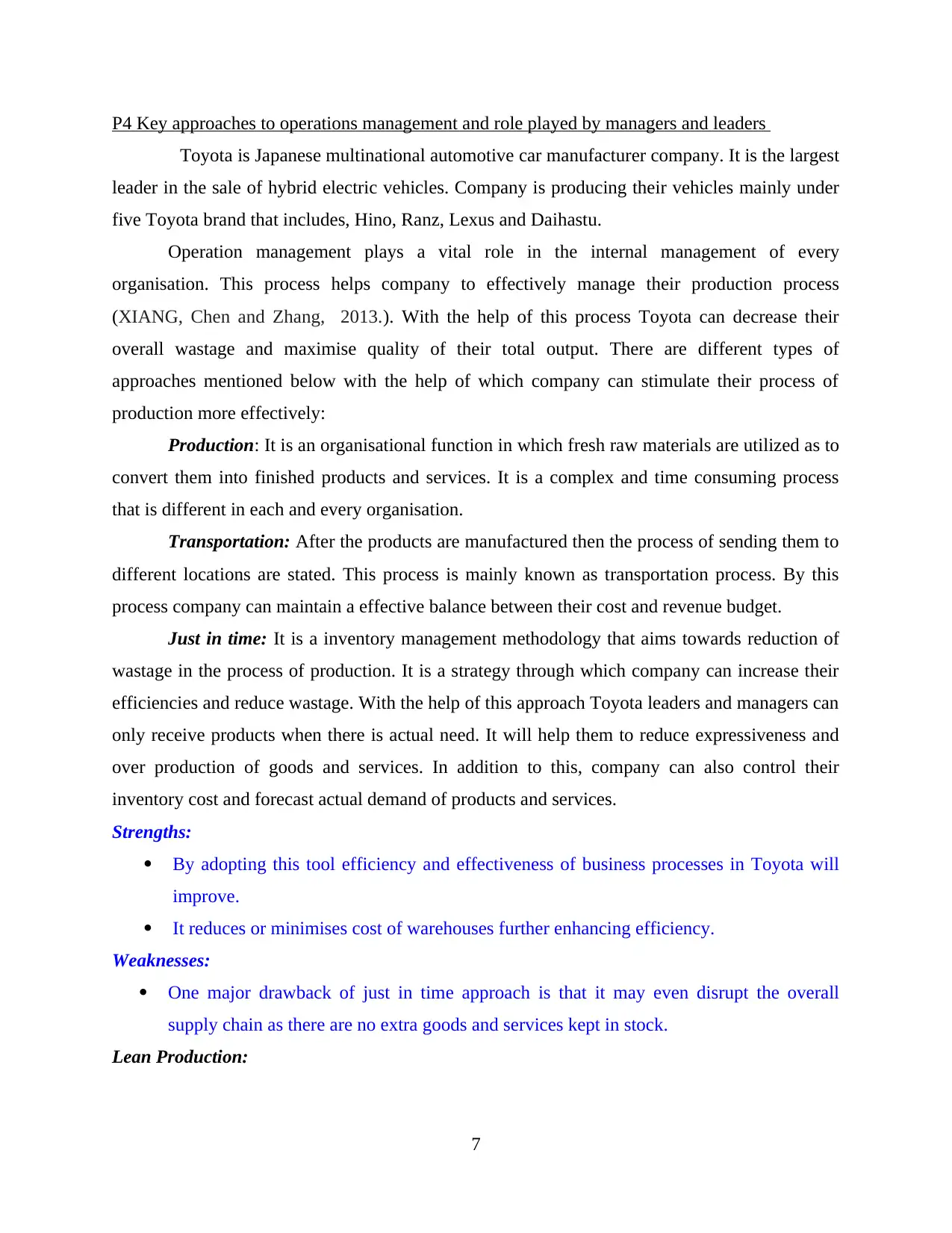
P4 Key approaches to operations management and role played by managers and leaders
Toyota is Japanese multinational automotive car manufacturer company. It is the largest
leader in the sale of hybrid electric vehicles. Company is producing their vehicles mainly under
five Toyota brand that includes, Hino, Ranz, Lexus and Daihastu.
Operation management plays a vital role in the internal management of every
organisation. This process helps company to effectively manage their production process
(XIANG, Chen and Zhang, 2013.). With the help of this process Toyota can decrease their
overall wastage and maximise quality of their total output. There are different types of
approaches mentioned below with the help of which company can stimulate their process of
production more effectively:
Production: It is an organisational function in which fresh raw materials are utilized as to
convert them into finished products and services. It is a complex and time consuming process
that is different in each and every organisation.
Transportation: After the products are manufactured then the process of sending them to
different locations are stated. This process is mainly known as transportation process. By this
process company can maintain a effective balance between their cost and revenue budget.
Just in time: It is a inventory management methodology that aims towards reduction of
wastage in the process of production. It is a strategy through which company can increase their
efficiencies and reduce wastage. With the help of this approach Toyota leaders and managers can
only receive products when there is actual need. It will help them to reduce expressiveness and
over production of goods and services. In addition to this, company can also control their
inventory cost and forecast actual demand of products and services.
Strengths:
By adopting this tool efficiency and effectiveness of business processes in Toyota will
improve.
It reduces or minimises cost of warehouses further enhancing efficiency.
Weaknesses:
One major drawback of just in time approach is that it may even disrupt the overall
supply chain as there are no extra goods and services kept in stock.
Lean Production:
7
Toyota is Japanese multinational automotive car manufacturer company. It is the largest
leader in the sale of hybrid electric vehicles. Company is producing their vehicles mainly under
five Toyota brand that includes, Hino, Ranz, Lexus and Daihastu.
Operation management plays a vital role in the internal management of every
organisation. This process helps company to effectively manage their production process
(XIANG, Chen and Zhang, 2013.). With the help of this process Toyota can decrease their
overall wastage and maximise quality of their total output. There are different types of
approaches mentioned below with the help of which company can stimulate their process of
production more effectively:
Production: It is an organisational function in which fresh raw materials are utilized as to
convert them into finished products and services. It is a complex and time consuming process
that is different in each and every organisation.
Transportation: After the products are manufactured then the process of sending them to
different locations are stated. This process is mainly known as transportation process. By this
process company can maintain a effective balance between their cost and revenue budget.
Just in time: It is a inventory management methodology that aims towards reduction of
wastage in the process of production. It is a strategy through which company can increase their
efficiencies and reduce wastage. With the help of this approach Toyota leaders and managers can
only receive products when there is actual need. It will help them to reduce expressiveness and
over production of goods and services. In addition to this, company can also control their
inventory cost and forecast actual demand of products and services.
Strengths:
By adopting this tool efficiency and effectiveness of business processes in Toyota will
improve.
It reduces or minimises cost of warehouses further enhancing efficiency.
Weaknesses:
One major drawback of just in time approach is that it may even disrupt the overall
supply chain as there are no extra goods and services kept in stock.
Lean Production:
7
⊘ This is a preview!⊘
Do you want full access?
Subscribe today to unlock all pages.

Trusted by 1+ million students worldwide
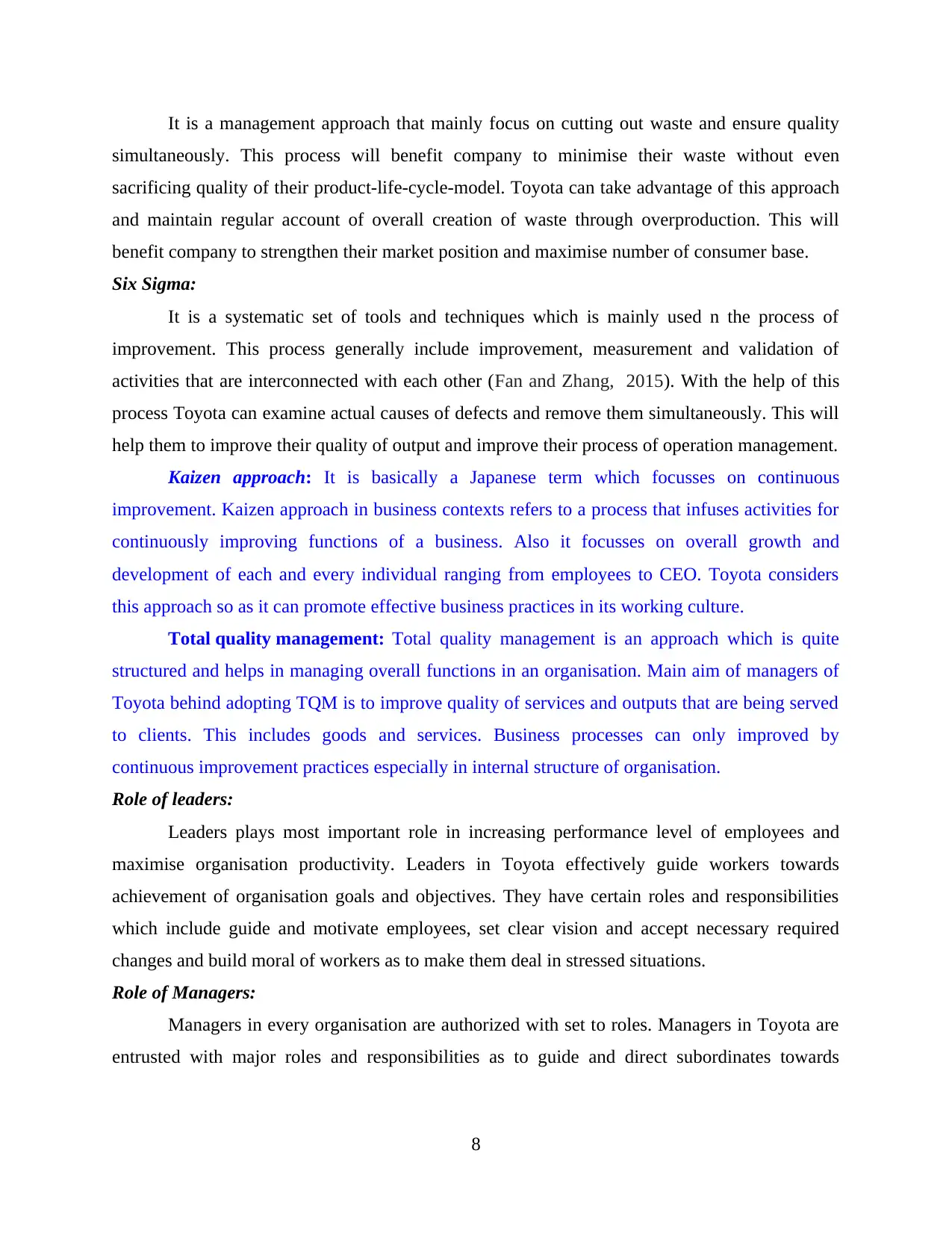
It is a management approach that mainly focus on cutting out waste and ensure quality
simultaneously. This process will benefit company to minimise their waste without even
sacrificing quality of their product-life-cycle-model. Toyota can take advantage of this approach
and maintain regular account of overall creation of waste through overproduction. This will
benefit company to strengthen their market position and maximise number of consumer base.
Six Sigma:
It is a systematic set of tools and techniques which is mainly used n the process of
improvement. This process generally include improvement, measurement and validation of
activities that are interconnected with each other (Fan and Zhang, 2015). With the help of this
process Toyota can examine actual causes of defects and remove them simultaneously. This will
help them to improve their quality of output and improve their process of operation management.
Kaizen approach: It is basically a Japanese term which focusses on continuous
improvement. Kaizen approach in business contexts refers to a process that infuses activities for
continuously improving functions of a business. Also it focusses on overall growth and
development of each and every individual ranging from employees to CEO. Toyota considers
this approach so as it can promote effective business practices in its working culture.
Total quality management: Total quality management is an approach which is quite
structured and helps in managing overall functions in an organisation. Main aim of managers of
Toyota behind adopting TQM is to improve quality of services and outputs that are being served
to clients. This includes goods and services. Business processes can only improved by
continuous improvement practices especially in internal structure of organisation.
Role of leaders:
Leaders plays most important role in increasing performance level of employees and
maximise organisation productivity. Leaders in Toyota effectively guide workers towards
achievement of organisation goals and objectives. They have certain roles and responsibilities
which include guide and motivate employees, set clear vision and accept necessary required
changes and build moral of workers as to make them deal in stressed situations.
Role of Managers:
Managers in every organisation are authorized with set to roles. Managers in Toyota are
entrusted with major roles and responsibilities as to guide and direct subordinates towards
8
simultaneously. This process will benefit company to minimise their waste without even
sacrificing quality of their product-life-cycle-model. Toyota can take advantage of this approach
and maintain regular account of overall creation of waste through overproduction. This will
benefit company to strengthen their market position and maximise number of consumer base.
Six Sigma:
It is a systematic set of tools and techniques which is mainly used n the process of
improvement. This process generally include improvement, measurement and validation of
activities that are interconnected with each other (Fan and Zhang, 2015). With the help of this
process Toyota can examine actual causes of defects and remove them simultaneously. This will
help them to improve their quality of output and improve their process of operation management.
Kaizen approach: It is basically a Japanese term which focusses on continuous
improvement. Kaizen approach in business contexts refers to a process that infuses activities for
continuously improving functions of a business. Also it focusses on overall growth and
development of each and every individual ranging from employees to CEO. Toyota considers
this approach so as it can promote effective business practices in its working culture.
Total quality management: Total quality management is an approach which is quite
structured and helps in managing overall functions in an organisation. Main aim of managers of
Toyota behind adopting TQM is to improve quality of services and outputs that are being served
to clients. This includes goods and services. Business processes can only improved by
continuous improvement practices especially in internal structure of organisation.
Role of leaders:
Leaders plays most important role in increasing performance level of employees and
maximise organisation productivity. Leaders in Toyota effectively guide workers towards
achievement of organisation goals and objectives. They have certain roles and responsibilities
which include guide and motivate employees, set clear vision and accept necessary required
changes and build moral of workers as to make them deal in stressed situations.
Role of Managers:
Managers in every organisation are authorized with set to roles. Managers in Toyota are
entrusted with major roles and responsibilities as to guide and direct subordinates towards
8
Paraphrase This Document
Need a fresh take? Get an instant paraphrase of this document with our AI Paraphraser
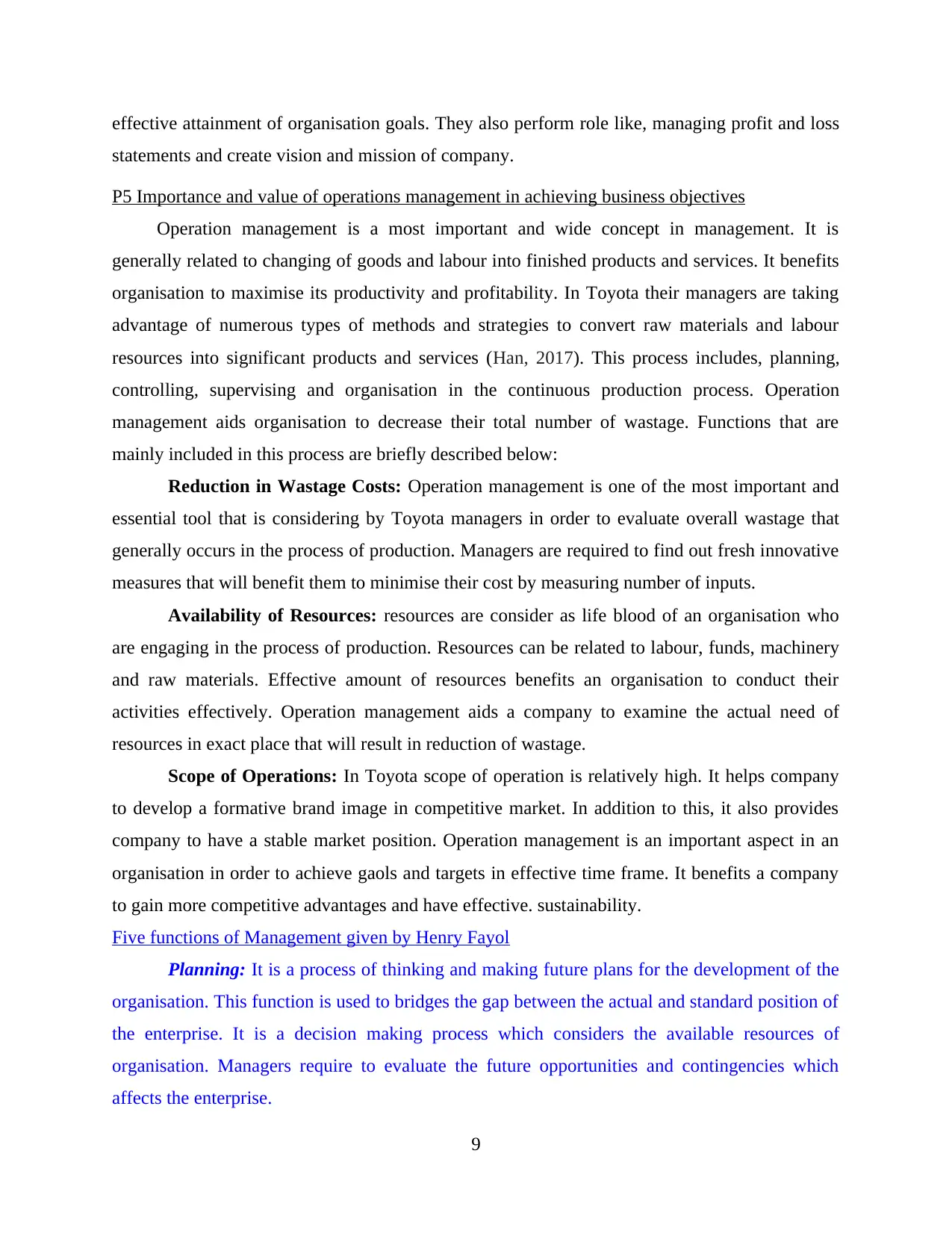
effective attainment of organisation goals. They also perform role like, managing profit and loss
statements and create vision and mission of company.
P5 Importance and value of operations management in achieving business objectives
Operation management is a most important and wide concept in management. It is
generally related to changing of goods and labour into finished products and services. It benefits
organisation to maximise its productivity and profitability. In Toyota their managers are taking
advantage of numerous types of methods and strategies to convert raw materials and labour
resources into significant products and services (Han, 2017). This process includes, planning,
controlling, supervising and organisation in the continuous production process. Operation
management aids organisation to decrease their total number of wastage. Functions that are
mainly included in this process are briefly described below:
Reduction in Wastage Costs: Operation management is one of the most important and
essential tool that is considering by Toyota managers in order to evaluate overall wastage that
generally occurs in the process of production. Managers are required to find out fresh innovative
measures that will benefit them to minimise their cost by measuring number of inputs.
Availability of Resources: resources are consider as life blood of an organisation who
are engaging in the process of production. Resources can be related to labour, funds, machinery
and raw materials. Effective amount of resources benefits an organisation to conduct their
activities effectively. Operation management aids a company to examine the actual need of
resources in exact place that will result in reduction of wastage.
Scope of Operations: In Toyota scope of operation is relatively high. It helps company
to develop a formative brand image in competitive market. In addition to this, it also provides
company to have a stable market position. Operation management is an important aspect in an
organisation in order to achieve gaols and targets in effective time frame. It benefits a company
to gain more competitive advantages and have effective. sustainability.
Five functions of Management given by Henry Fayol
Planning: It is a process of thinking and making future plans for the development of the
organisation. This function is used to bridges the gap between the actual and standard position of
the enterprise. It is a decision making process which considers the available resources of
organisation. Managers require to evaluate the future opportunities and contingencies which
affects the enterprise.
9
statements and create vision and mission of company.
P5 Importance and value of operations management in achieving business objectives
Operation management is a most important and wide concept in management. It is
generally related to changing of goods and labour into finished products and services. It benefits
organisation to maximise its productivity and profitability. In Toyota their managers are taking
advantage of numerous types of methods and strategies to convert raw materials and labour
resources into significant products and services (Han, 2017). This process includes, planning,
controlling, supervising and organisation in the continuous production process. Operation
management aids organisation to decrease their total number of wastage. Functions that are
mainly included in this process are briefly described below:
Reduction in Wastage Costs: Operation management is one of the most important and
essential tool that is considering by Toyota managers in order to evaluate overall wastage that
generally occurs in the process of production. Managers are required to find out fresh innovative
measures that will benefit them to minimise their cost by measuring number of inputs.
Availability of Resources: resources are consider as life blood of an organisation who
are engaging in the process of production. Resources can be related to labour, funds, machinery
and raw materials. Effective amount of resources benefits an organisation to conduct their
activities effectively. Operation management aids a company to examine the actual need of
resources in exact place that will result in reduction of wastage.
Scope of Operations: In Toyota scope of operation is relatively high. It helps company
to develop a formative brand image in competitive market. In addition to this, it also provides
company to have a stable market position. Operation management is an important aspect in an
organisation in order to achieve gaols and targets in effective time frame. It benefits a company
to gain more competitive advantages and have effective. sustainability.
Five functions of Management given by Henry Fayol
Planning: It is a process of thinking and making future plans for the development of the
organisation. This function is used to bridges the gap between the actual and standard position of
the enterprise. It is a decision making process which considers the available resources of
organisation. Managers require to evaluate the future opportunities and contingencies which
affects the enterprise.
9
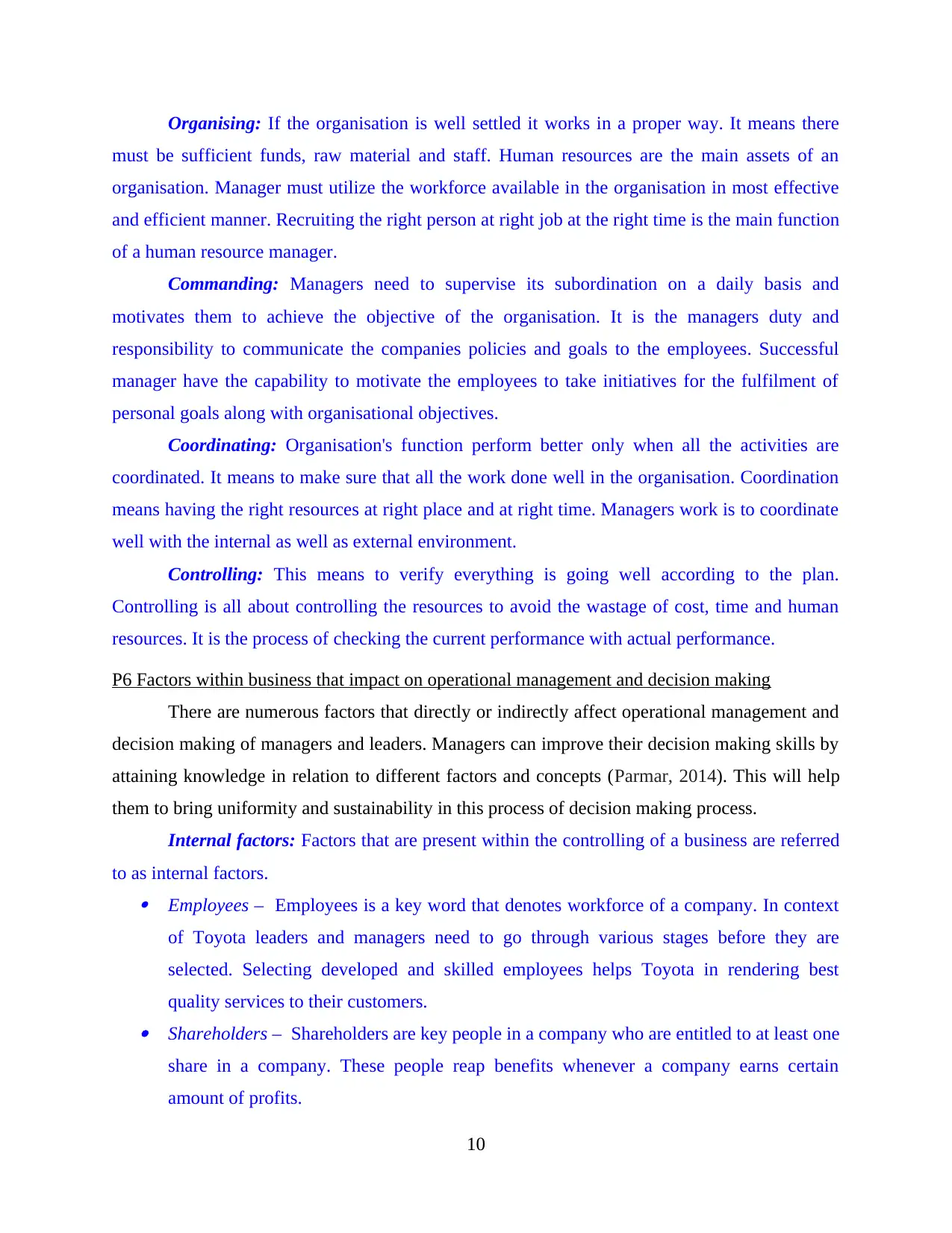
Organising: If the organisation is well settled it works in a proper way. It means there
must be sufficient funds, raw material and staff. Human resources are the main assets of an
organisation. Manager must utilize the workforce available in the organisation in most effective
and efficient manner. Recruiting the right person at right job at the right time is the main function
of a human resource manager.
Commanding: Managers need to supervise its subordination on a daily basis and
motivates them to achieve the objective of the organisation. It is the managers duty and
responsibility to communicate the companies policies and goals to the employees. Successful
manager have the capability to motivate the employees to take initiatives for the fulfilment of
personal goals along with organisational objectives.
Coordinating: Organisation's function perform better only when all the activities are
coordinated. It means to make sure that all the work done well in the organisation. Coordination
means having the right resources at right place and at right time. Managers work is to coordinate
well with the internal as well as external environment.
Controlling: This means to verify everything is going well according to the plan.
Controlling is all about controlling the resources to avoid the wastage of cost, time and human
resources. It is the process of checking the current performance with actual performance.
P6 Factors within business that impact on operational management and decision making
There are numerous factors that directly or indirectly affect operational management and
decision making of managers and leaders. Managers can improve their decision making skills by
attaining knowledge in relation to different factors and concepts (Parmar, 2014). This will help
them to bring uniformity and sustainability in this process of decision making process.
Internal factors: Factors that are present within the controlling of a business are referred
to as internal factors. Employees – Employees is a key word that denotes workforce of a company. In context
of Toyota leaders and managers need to go through various stages before they are
selected. Selecting developed and skilled employees helps Toyota in rendering best
quality services to their customers. Shareholders – Shareholders are key people in a company who are entitled to at least one
share in a company. These people reap benefits whenever a company earns certain
amount of profits.
10
must be sufficient funds, raw material and staff. Human resources are the main assets of an
organisation. Manager must utilize the workforce available in the organisation in most effective
and efficient manner. Recruiting the right person at right job at the right time is the main function
of a human resource manager.
Commanding: Managers need to supervise its subordination on a daily basis and
motivates them to achieve the objective of the organisation. It is the managers duty and
responsibility to communicate the companies policies and goals to the employees. Successful
manager have the capability to motivate the employees to take initiatives for the fulfilment of
personal goals along with organisational objectives.
Coordinating: Organisation's function perform better only when all the activities are
coordinated. It means to make sure that all the work done well in the organisation. Coordination
means having the right resources at right place and at right time. Managers work is to coordinate
well with the internal as well as external environment.
Controlling: This means to verify everything is going well according to the plan.
Controlling is all about controlling the resources to avoid the wastage of cost, time and human
resources. It is the process of checking the current performance with actual performance.
P6 Factors within business that impact on operational management and decision making
There are numerous factors that directly or indirectly affect operational management and
decision making of managers and leaders. Managers can improve their decision making skills by
attaining knowledge in relation to different factors and concepts (Parmar, 2014). This will help
them to bring uniformity and sustainability in this process of decision making process.
Internal factors: Factors that are present within the controlling of a business are referred
to as internal factors. Employees – Employees is a key word that denotes workforce of a company. In context
of Toyota leaders and managers need to go through various stages before they are
selected. Selecting developed and skilled employees helps Toyota in rendering best
quality services to their customers. Shareholders – Shareholders are key people in a company who are entitled to at least one
share in a company. These people reap benefits whenever a company earns certain
amount of profits.
10
⊘ This is a preview!⊘
Do you want full access?
Subscribe today to unlock all pages.

Trusted by 1+ million students worldwide
1 out of 16
Related Documents
Your All-in-One AI-Powered Toolkit for Academic Success.
+13062052269
info@desklib.com
Available 24*7 on WhatsApp / Email
![[object Object]](/_next/static/media/star-bottom.7253800d.svg)
Unlock your academic potential
Copyright © 2020–2025 A2Z Services. All Rights Reserved. Developed and managed by ZUCOL.





